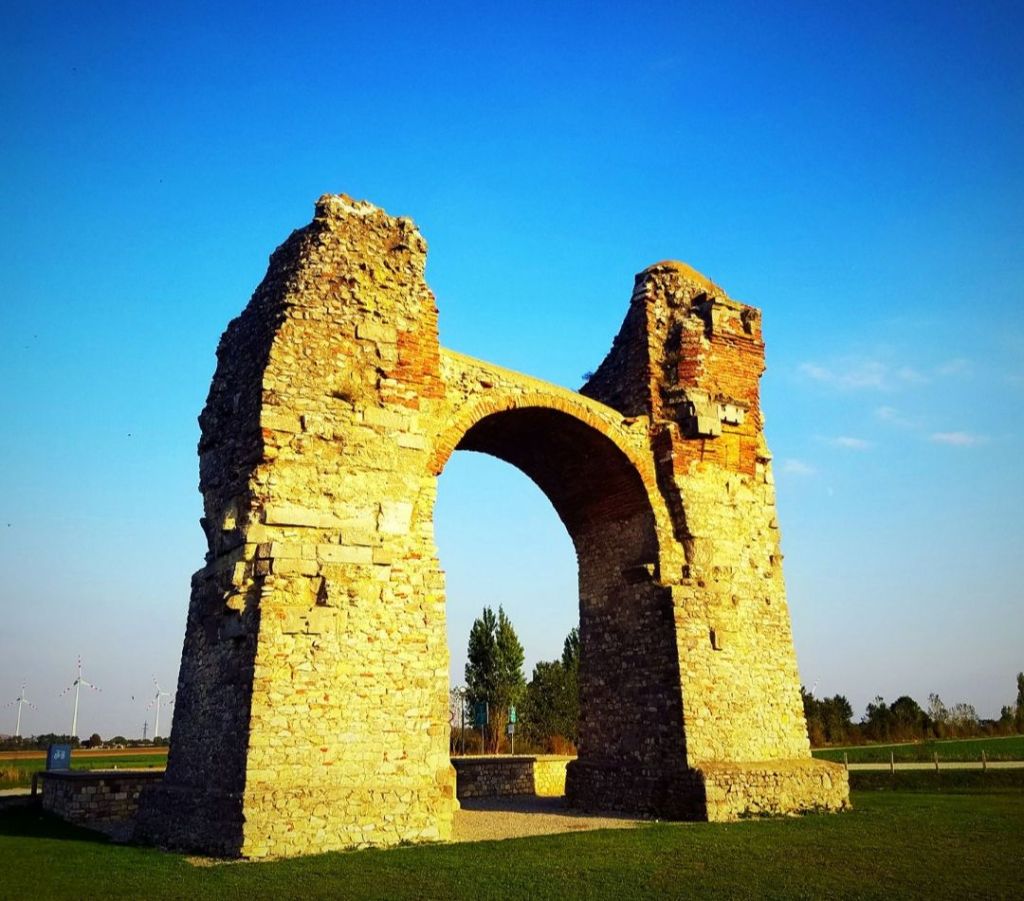At the heart of the old ruins of Carnuntum is the Heidentor — the Heathen Gate! It is here that Guido von List made several sacred pilgrimages. On June 26th 1911, List and eight friends dedicated themselves to the High Armanen Order at Carnuntum’s Heathen Gate. Of this sacred site, List recorded, “Here in this place the stones speak, the earth murmurs, and whispers come from the grass as if from the graves!” But what do we know about Carnuntum?

Lets take an overview of the timeline of Carnuntum, and surrounding area, from prehistoric cultures and the Celtic presence, the eventual rise of Carnuntum under Roman rule, Christianization, till the present.
Various archaeological cultures dominated over time Eastern Austria and Central Europe, spanning from the Early Bronze Age to the La Tène Culture.
Early Bronze Age (2300–1600 BC):The Únětice culture culture flourished in the Early Bronze Age. In eastern Austria the Early Bronze Age exhibits regional variations in material culture, burial practices, and other features. Three main groups existed: Únětice culture north of the Danube, Unterwölbling culture south of the Danube River Alps foreland, and the Wieselburg or Gata group south of the Danube.
Middle Bronze Age (c. 1600 to 1300 BC):
The Tumulus culture, successor to the Únětice culture, is characterized by tumulus burials (burials beneath mounds).
Late Bronze Age (c. 1300–750 BC):The Urnfield culture developed from the Tumulus culture, the Urnfield culture is known for cremating the dead and burying their ashes in urns.
Hallstatt Culture (1200 – 450 BC): Evolving from the Urnfield culture, the Hallstatt culture is associated with the Celts and the development of ironworking. It flourished around Carnuntum.
La Tène Culture (450 BC – 50 BC): The La Tène culture, known for its intricate art style, succeeded the Hallstatt culture and spread across much of Europe, including the Carnuntum area.
1st century BC – 1st century AD: Germanic tribes, including the Suebi (Suebians), began migrating into Central Europe. Some Suebi groups like the Marcomanni and Quadi settled north of the Danube River, near present-day Bohemia and Moravia.
Around 6 AD: The Romans establish a military camp at Carnuntum, likely due to its strategic location on the Danube near Germanic settlements.
1st century AD onwards: Carnuntum develops into a major Roman military city. The presence of a legion and its auxiliary troops attracts traders and civilians, transforming it into a significant trade center.
2nd century AD: The Roman province of Pannonia Superior is established, with Carnuntum as its capital. Emperor Marcus Aurelius resides in Carnuntum during his campaign against the Marcomanni. And it was here that he wrote part of his famous “Meditations”. In his Meditations, Roman emperor Marcus Aurelius mentions Carnuntum in Book II, passage 11. He reflects on the impermanence of life, stating that “all things are in a state of change, and nought stands still.” He uses Carnuntum as the location where this reflection came to him.
3rd century AD: Carnuntum reaches its peak under the Severan dynasty. Septimius Severus is proclaimed emperor by his troops stationed here.
The Roman city of Carnuntum, located near the Danube frontier, served as a significant military center. Soldiers stationed there during the 1st to 3rd centuries AD embraced the cult of Jupiter Dolichenus, a war god from Syria. Although there’s no evidence of a major temple, dedicatory inscriptions and statuettes found in Carnuntum point to his veneration. This popularity reflects the city’s military character, with soldiers likely bringing their worship of this particular god associated with victory and war. Jupiter Dolichenus was typically depicted standing on a bull, wielding a thunderbolt and a double-axe, symbolizing his power over war and victory.
4th century AD: As the Roman Empire weakens, Germanic pressure on the borders intensifies. Carnuntum suffers barbarian invasions and loses its prominence.
Carnuntum’s fortunes began to decline in the 4th century, as the Roman Empire was weakened by barbarian invasions. The city was eventually destroyed by barbarian invaders in 374 AD, and it was never really rebuilt.
The Marcomanni converted to Christianity towards the end of the fourth century when Fritigil, their queen, obtained help from Ambrose, the formidable bishop of Milan (Italy), and also persuaded her husband to place himself and his people under Roman protection. The Roman Emperor, Constantius II defeated the Quadi and the Goths on the Danube in 359.
The city began to decline in the 4th century due to barbarian invasions and political instability within the Roman Empire. By the 5th century, Carnuntum was largely abandoned.
The area around Carnuntum was sparsely populated during Middle Ages and Early Modern Period (5th Century-18th Century). The ruins of the city were used as a source of building materials, and some medieval structures were built on top of the Roman foundations.
In the 18th century, there was a renewed interest in Roman history, and Carnuntum became the focus of archaeological excavations. These excavations have continued into the 21st century, revealing more about the city’s history and importance.
Recent excavations showed that there was a Gladiator school and arena in Carnuntum. It was a cosmopolitan area of violence, spirituality and opulence.
Carnuntum’s legacy lives on. The ruins of the city are still visible today, and they are a reminder of the city’s once-great importance. Carnuntum is now a popular tourist destination and an important archaeological site. The Austrian government has invested in preserving the ruins and developing a museum on the site.
